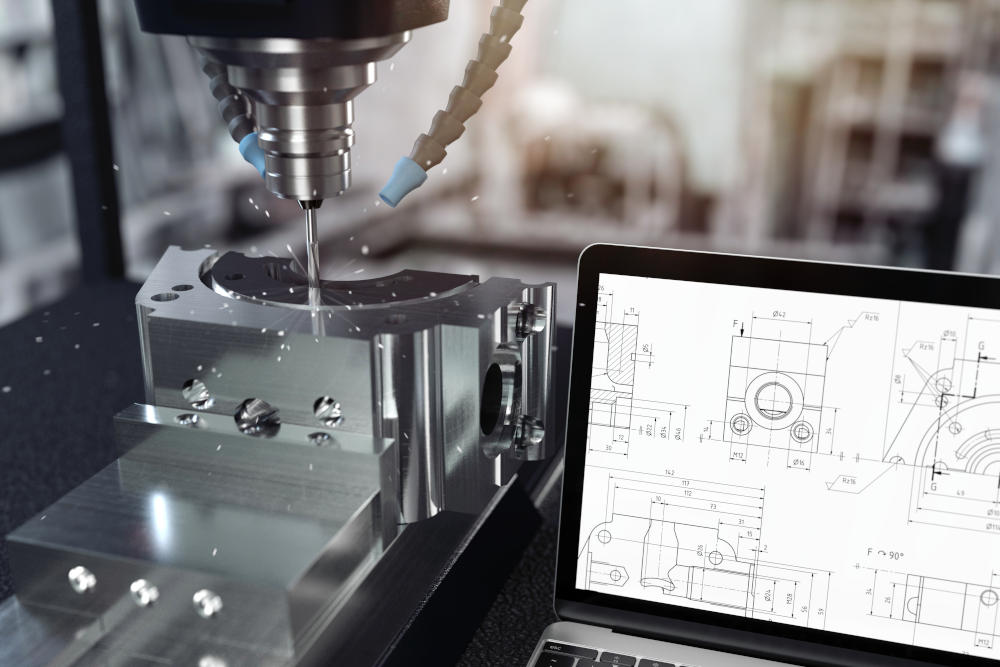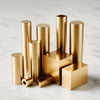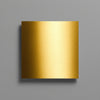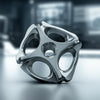Aluminum Rapid Prototyping: Its Advantages and Applications

Why CNC machining so impressive and applicable across so many different industrials? The answer is the high degree of accuracy and precision offered by CNC machines.
It's a complex procedure of making aluminum prototypes, even though CNC machines can simplify it. Furthermore, the success of your projects depends on the aluminum alloy you choose too.
In this blog, we'll delve into CNC aluminum rapid prototyping, its advantages, and applications. Let's we get started...
A Brief Guide about Aluminium Rapid Prototyping
Aluminum rapid prototyping is a manufacturing method for quickly producing physical, functional prototypes and components from aluminum alloys, significantly reducing the time and cost associated with traditional manufacturing processes. It uses technologies like 3D printing (additive manufacturing)where layers of aluminum are deposited to build a part, or CNC machining (subtractive manufacturing), which precisely carves parts from a solid block of aluminum. This allows engineers to test and refine designs in the real world, accelerating product development and reducing the risk of costly errors before full-scale production.
Why Choose Aluminum for CNC Machining Prototyping?
1. Exceptional Machinability
Aluminum boasts superior machinability with a cutting force that is approximately 3.6 times faster than 1212 steel. This significantly reduces processing time, making it ideal for rapid prototyping where speed is essential. The material's soft yet durable nature allows CNC machine tools to cut it quickly with minimal deformation during milling, ensuring higher precision and maintaining dimensional stability throughout the process.
2. Optimal Strength-to-Weight Ratio
With one-third the density of steel, aluminum provides an exceptional strength-to-weight ratio that makes it perfect for weight-sensitive applications. This combination of toughness and lightness is particularly valuable in industries like aerospace and automotive where every gram counts without compromising structural integrity. Different aluminum grades serve distinct purposes—while 6061 is used for numerous products, 7075 is preferred in aircraft industry and marine applications.
3. Cost-Effectiveness
Aluminum offers significant cost advantages over many alternative materials. It's cheaper than zinc or copper, though slightly more expensive than steel. The economic benefits extend throughout the production cycle since aluminum chips and waste material can be recycled, potentially recovering some of your initial investment. Notably, recycling aluminum requires only 8% of the energy needed for primary aluminum production, making it both economically and environmentally sustainable.
4. Superior Corrosion Resistance
As a nonferrous material, aluminum naturally resists rust and corrosion. The most common aluminum grade, 6061, exhibits particular resistance to moisture, chemical damage, oxidation, and rust. This inherent corrosion resistance can be further enhanced through anodization, extending the metal's endurance and maintaining prototype integrity even in harsh environments.
5. Excellent Electrical Conductivity
Pure aluminum conducts 37.7 million siemens per meter at room temperature, making it valuable for electrical components. While aluminum alloys have slightly reduced conductivity compared to pure aluminum, they remain ideal for creating prototypes that require electrical functionality. This property is particularly beneficial for electronic enclosures, heat sinks, and electrical connectors.
6. Sustainability and Recyclability
CNC machining is inherently subtractive, generating significant material waste in the form of chips. However, aluminum can be fully recycled with minimal energy investment. Modern recycling processes for twisted aluminum plates consume only 8% of the energy required for primary aluminum production, significantly reducing the environmental impact of prototyping operations.
Table: Comparison of Aluminum Grades for CNC Prototyping
| Grade | Tensile Strength | Yield Strength | Characteristics | Common Applications |
|---|---|---|---|---|
| 6061 | 45 ksi (310 MPa) | 40 ksi (276 MPa) | Good machinability, weldability, corrosion resistance | Automotive parts, consumer goods, structural components |
| 7075 | 83 ksi (572 MPa) | 73 ksi (503 MPa) | High strength, fatigue resistance | Aerospace, marine applications |
| 2024 | 68 ksi (469 MPa) | 47 ksi (324 MPa) | High strength-to-weight ratio | Aircraft structures, transportation |
| 5052 | 33 ksi (228 MPa) | 28 ksi (193 MPa) | Excellent corrosion resistance, formability | Marine applications, electronic chassis |
Real-World Case Studies

Case Study 1: Automotive Excellence in China
JF Wheel Co., Ltd., a high-tech enterprise with a total investment of $3 billion, exemplifies aluminum's automotive applications. Their automated production lines supply aluminum alloy wheels to major electric vehicle manufacturers like Chery and Changan. The company achieves remarkable precision of 0.01 mm (approximately one-tenth the diameter of a human hair) through digital central control systems that track over 200 data points for each wheel in real-time. This (smart manufacturing) approach maintains industry-leading product defect rates while meeting the stringent requirements of automotive OEMs.
Case Study 2: Complex Architectural Forms
A revolutionary twisted aluminum panel technology has enabled architectural breakthroughs that were previously impossible. The technology uses algorithmic control over thousands of micro-hydraulic rams to apply multi-point progressive pressure to aluminum panels, allowing even 6mm thick aluminum to be shaped into spiral curves with a minimum radius of 0.5 meters. This process was used for the dome of a Shanghai art center, where 263 unique curved aluminum panels were assembled with errors not exceeding 1.5 mm, creating continuous water-wave-like light reflections.
Case Study 3: Furniture Prototyping
Danish industrial design company VIPP collaborated with TEAM Rapid on a lounge chair prototype requiring both aesthetic appeal and structural integrity. Using Aluminum 6061, they produced a complete unit consisting of 7 components within just 10 calendar days. The choice of aluminum provided the necessary load-bearing capacity without joints or welds, while maintaining lightweight characteristics essential for furniture. The machined surface finish allowed for subsequent specialized post-processing and decoration, demonstrating aluminum's versatility for functional prototypes.
Aluminum Alternatives in CNC Prototyping
While aluminum offers numerous benefits, other materials may be preferable for specific applications:
-
Brass: A copper-zinc alloy that machines beautifully for large orders, often used in valves and nozzles where machining time matters.
-
Copper: Offers better electrical conductivity but is more difficult to machine in its pure form. Copper alloys can approach aluminum's machinability.
-
Steel and Stainless Steel: Provide greater strength but add weight. Stainless steel offers excellent rust resistance after treatment but may be unsuitable for weight-sensitive applications.
-
Magnesium: Even lighter than aluminum but rarely used due to its tendency to combust during machining.
Industry Applications of CNC Aluminum Prototyping
-
Aerospace Industry: Aluminum's high strength-to-weight ratio makes it ideal for aircraft fittings and components. NASA is even developing "morphing wings" with intelligent aluminum panels that can change aerodynamic shape during flight, potentially reducing aircraft fuel consumption by 15%.
-
Automotive Sector: Beyond traditional components, aluminum prototyping is crucial for new energy vehicles. Companies like Guotai Aluminum are using CNC machining centers worth millions to process new energy vehicles threshold beams with micron-level precision. Their self-developed aluminum materials have received international certification and are exported to European countries.
-
Electrical Industry: Aluminum's balanced properties make it ideal for electrical components and heat sinks. Although pure copper conducts electricity slightly better, aluminum's superior machinability, lighter weight, and lower cost often make it the preferred choice for electrical enclosures and components.
-
Medical Devices: Certain aluminum alloys (6063, 6061, and 3003) demonstrate complete biocompatibility with human tissue. This makes them suitable for medical devices where titanium might be otherwise preferred but would be more expensive and difficult to machine.
-
Architecture and Construction: Beyond the twisted panels mentioned earlier, aluminum prototyping enables custom architectural elements with complex geometries. The technology supports "responsive building skin" systems that can adapt to environmental conditions, such as airport shading systems that automatically unfold into drainage surfaces during rain and contract into sun-shading grids in sunny weather.
The Future of Aluminum Prototyping

Emerging technologies are pushing the boundaries of what's possible with aluminum prototyping:
-
Active Aluminum Composites: MIT researchers have developed aluminum embedded with shape memory alloy fibers that can bend autonomously when electrified. A 2-square-meter smart aluminum panel can transform from flat to saddle-shaped in 90 seconds while supporting up to 200 kg of weight.
-
Micro-Scale Applications: Harvard researchers are developing millimeter-scale micro-twisted aluminum panel arrays for use in variable-focus optical lenses.
-
Wearable Technology: Korean researchers are weaving aluminum into wearable exoskeletons for patient rehabilitation training, demonstrating aluminum's potential in medical technology.
Conclusion
CNC aluminum prototyping continues to be an indispensable technology for product development across industries. Its unique combination of machinability, strength-to-weight ratio, corrosion resistance, and sustainability makes it particularly valuable in an era focused on both performance and environmental responsibility.
As manufacturing technologies advance—with innovations like algorithmically controlled progressive forming and active aluminum composites—the possibilities for aluminum prototyping continue to expand. These developments enable designers and engineers to move beyond limitations of manufacturability and focus instead on what should be built, unleashing new levels of creativity and functionality.
For businesses seeking to leverage these advantages, partnering with experienced CNC prototyping services ensures access to the latest technologies and expertise, transforming innovative ideas into high-quality physical prototypes with speed and precision.
-
Posted in
Aluminum prototyping, cnc machining, rapid prototyping





